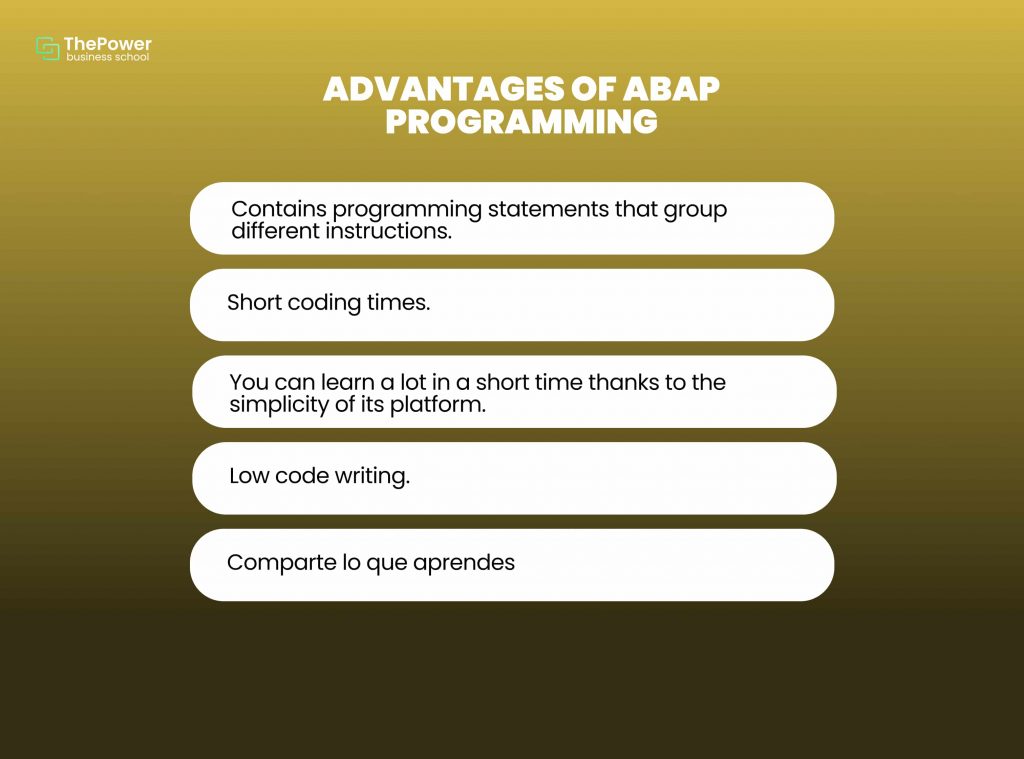
Franco Brutti
Would you like to take a leap in your professional life and acquire new knowledge in a programming language? Well, the time has come for you to take a look at Abap.
It’s a language that aims to program most of a company's products, so we’ll say that you could become a specialist in the creation of computer products.
Get ready to give new functionalities to the products your company sells and be a fundamental part of the company. Are you up for it?
What is ABAP?
Abap is a programming language considered the fourth generation that is owned by the SAP company and uses Open SQL statements to connect to any database.
Inside it, there are thousands of functions for managing databases, dates, and files and it gives you the ability to generate connections to connect to all systems with another platform.
The project was thought of as a programming language that has the purpose of allowing users to manipulate the information, but at the end of the day, the appearance of expert programmers was necessary to execute its developments.
In this sense, Abap remained as the development language for the following client server versions of Sap R/3 that were implemented in the market in 1992, where practically the whole system except the basics was written in Abap.
However, in 1999 Sap released an object-oriented extension called Abap Objects.
What is ABAP for?
Abap has the particularity of providing you with executable code for other programs that are not executed independently.
In this way, the system identifies two types of programs:
Reports.
Module pool.
Reports follow a simple structure in which the user adds a set of parameters and the program uses them to generate a report in the form of an interactive list. This concept can be misleading since reports can be designed to modify data because they have this name due to the oriented list they produce as output.
On the other hand, module pools determine more complex interaction patterns through a collection of screens, i.e., what users can actually see.
Therefore, each screen has an implicit Abap code that is invoked by the screens and each has its logical flow that is divided into PBO and PAL. Among the types of non-executable programs that we find today, we have:
Include Modules.
Subroutine pools.
Function groups.
Object classes.
Interfaces.
Type pools.
An include module includes at generation time in the calling unit, which is often used to divide very long programs. On the other hand, subroutine pools contain Abap subroutines and function groups are function module libraries.
On the other hand, object classes and interfaces are very similar to Java interfaces and the former determines methods and attributes, while the latter has the definition of the methods.
Abap Work Platform
The Abap worksite has different alternatives to edit programs. Some of them are:
Editor for writing reports includes module pools and subroutine pools.
Database dictionary that allows you to process table definitions and retrieve global types.
Menu Painter, which gives you the possibility of designing the user interface, from menu bars, key assignments, and applications.
Screen painter for designing everything related to logical flows and designing screens.
Function builder for function modules.
Abap Versions
Abap has different versions that you can choose from depending on the needs you have at that moment. Let's see some of them below:
1. Abap Sap
This version offers all kinds of courses and lessons on everything related to classic Abap application programming. Here they are used in the Sap ERP, which is perfect for consultants or developers who want to learn to program in this language from scratch.
2. Abap 1.4
In second place we have Abap 1.4, which are articles and posts that are aimed at programmers who have already had approaches to the features of Abap and have the goal of learning a new language.
These articles and posts are specifically designed for programmers who have already been exposed to Abap topics and have the objective of understanding the language syntax.
4. Abap On Hana
Meanwhile, this version is developed for those programmers who have advanced knowledge in this programming language and aim to develop with the HANA database engine.
Meanwhile, this version is intended for developers who have significant knowledge of the language and are looking to create new projects with the HANA database engine.
5. Abap On Cloud
Finally, we have Abap on the cloud, which is a series of tutorials that are aimed at consultants who know how to program in Abap in an advanced way.
Abap Features
The main characteristic of Abap is that it’s a fourth-generation language, which means that it’s a language that has prefabricated sentences that emulate English and it’s far away from being a low-level language.
In this sense, the platform has different tools that allow the construction of different types of objects that belong to the repository. In turn, SAP, the owner company, provides tools organized through transactions that allow us to identify the type of object we want to build.
Some of these tools are:
The source-code editor can be executed with transaction SE38.
Availability of a database that allows you to develop different objects such as data elements, structures, tables, and finding aids.
Screen builder that gives you the possibility of building user interfaces.
Exception builder.
Advantages of ABAP programming
There are many advantages that Abap programming offers you. Some of them are:
It contains programming statements that group different instructions.
Short coding times.
You can learn a lot in a short time thanks to the simplicity of its platform.
Low code writing.

Abap Layers
It's time to take a look at Abap layers. Pay close attention and take note:
1. Database layer.
It’s a database where all data sets are stored and installed on a server that is dedicated to data management.
2. Application layer
The application layer is the Abap virtual machine on which most of the programs are executed. It’s characterized by the fact that this layer can be sent through different application servers that are installed on different computers where it’s not mandatory that the operating systems are the same.
3. Presentation layer
Finally, we have the so-called presentation layer, which is the user interface and it’s where the Sap screens are loaded, where the client interacts with the system.
There is no doubt that Abap is an ideal programming language for those who want to create products with SAP and who already have knowledge about it. However, if you are a beginner you can quickly learn how to develop objects with one of the languages that has had more growth in recent times.
Are you up for the challenge of joining the new trend?
Oct 14, 2022








